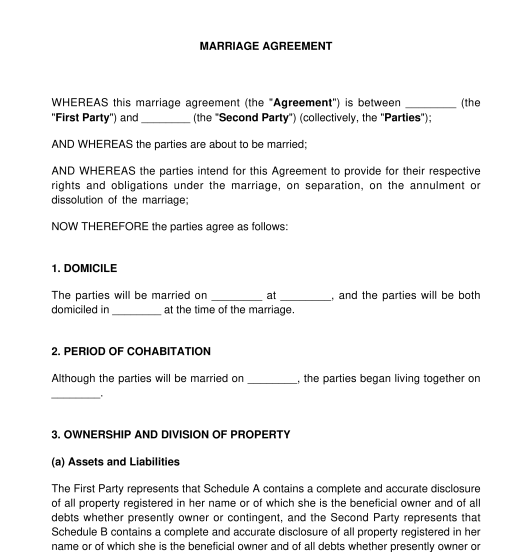 11/09/2025
11/09/2025

Answer a few questions and your document is created automatically.

Your document is ready! You will receive it in Word and PDF formats. You will be able to modify it.

 11/09/2025
11/09/2025
 Word and PDF
Word and PDF
 9 to 13 pages
9 to 13 pages
This Marriage Agreement (otherwise known as a Prenuptial Agreement in the USA), is a contract entered into by two individuals who are about to get married or are already married. This Agreement outlines the financial obligations of both Parties and includes a plan of how to divide assets and debt obligations if the marriage ever comes to an end (the spouses are called the "Parties").
Marriage Agreements are often associated with individuals who have a large number of assets. However, a Marriage Agreement can be used in many different situations, such as the following:
If a couple does not have a Marriage Agreement (or other domestic contract) in place when they divorce, provincial or territorial laws and courts are left to decide how to divide property, dictate support, and allocate debt.
By creating a Marriage Agreement, the terms the Parties agreed to are used instead of the default guidance of provincial or territorial law. A Marriage Agreement, like any contract, can be challenged in court, but a Marriage Agreement creates the initial presumption that the Parties agreed to its contents and want to follow those guidelines they agreed on. A thorough and successful Marriage Agreement can drastically speed up divorce litigation, or even avoid it altogether in the event of a divorce.
In order to complete a Marriage Agreement, the Parties should work together to disclose their assets to each other, decide how they would like to outline their financial obligations, and make arrangements should the marriage end. A Marriage Agreement covers several major areas as follows:
1. Assets and Debts
This Agreement allows the Parties to describe any assets or debts that they are bringing to the marriage. Failure of either Party to disclose all assets and financial information to the other Party may result in the invalidity of the Agreement so it is important that both parties disclose all assets and financial information. All of this information should be written down separately to the Agreement and attached to the Agreement as either Schedule A or B, depending on the party.
2. Property
The Parties can specify what, if anything, will be considered shared property subject to division. For example, couples often decide that the property they acquired separately before the marriage should remain separate property not subject to division after the marriage. This consideration is especially important if either of the Parties has inherited property or has a great deal of assets.
3. Matrimonial Home
If the Parties plan own a house or are planning to purchase a house together after the marriage, this section of the Agreement allows them to outline matters related to the matrimonial home, such as payment of expenses related to maintenance of the marital residence, and responsibility for shared living expenses. There are many different ways for a couple to manage their finances together, whether they maintain separate bank accounts and each take on different bills or if they have a joint bank account that they both contribute to.
4. Children
If one or both of the Parties has children from a prior relationship, they can specify this. This portion of the agreement allows the Parties to dictate whether they plan to provide a home and reasonable support for each others children from a prior relationship without creating an obligation to continue that support should the marriage end. This section also allows the Parties to list any children they have had together.
5. Spousal Support
This Agreement allows the Parties to outline whether or not one Party will pay spousal support to the other Party if they divorce in the future. Spousal support is generally paid to the Party who made less money during the marriage. If the Parties already know that one of them will not be working or will be making significantly less money, spousal support payments can be negotiated and planned ahead of time using the Marriage Agreement.
A Marriage Agreement can be ruled invalid in the following situations that the Parties should be careful to avoid:
The Parties should make every effort to complete the Agreement well in advance of the marriage; thirty days is a common guideline. Further, they should both have a reasonable amount of time to review the completed Agreement prior to signing. After completing the Agreement, the Parties may independently obtain legal advice. The Parties may agree to each consult with a lawyer prior to executing the document due to the nature of the important and personal rights involved.
The Parties do not need to file their Agreement anywhere once it is completed. However, signed copies of the document should be kept in a safe and secure location such as a safe, bank safety deposit box, or with a lawyer.
If circumstances change, such as one of the Parties loses their job and can no longer fulfill the financial obligations as detailed in the Marriage Agreement, or the Parties decide they want to make new arrangements, they do not need to write an entirely new document. By using an Amendment to an Agreement document, the Parties can easily add, delete, or rewrite portions of the Agreement as desired or necessary.
This Marriage Agreement is subject to the laws of the province or territory in which the parties usually reside.
You fill out a form. The document is created before your eyes as you respond to the questions.
At the end, you receive it in Word and PDF formats. You can modify it and reuse it.
Marriage Agreement - Sample, template - Word & PDF
Country: Canada (English)